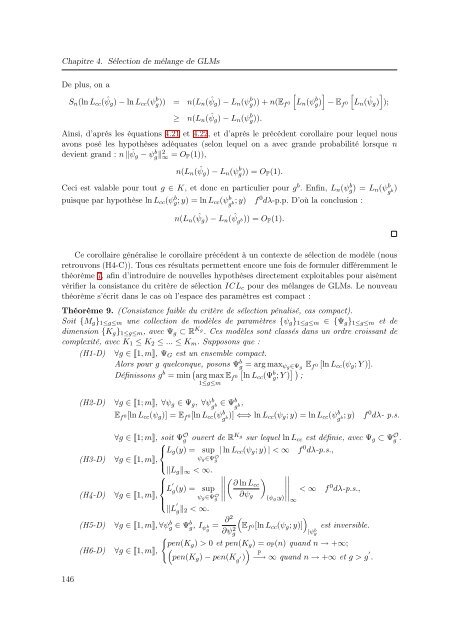Mélanges de GLMs et nombre de composantes : application ... - Scor
Mélanges de GLMs et nombre de composantes : application ... - Scor
Mélanges de GLMs et nombre de composantes : application ... - Scor
Create successful ePaper yourself
Turn your PDF publications into a flip-book with our unique Google optimized e-Paper software.
Chapitre 4. Sélection <strong>de</strong> mélange <strong>de</strong> <strong>GLMs</strong><br />
De plus, on a<br />
S n (ln L cc ( ˆψ g ) − ln L cc (ψ b g)) = n(L n ( ˆψ g ) − L n (ψ b g)) + n(E f 0<br />
≥<br />
n(L n ( ˆψ g ) − L n (ψ b g)).<br />
[ ] [<br />
L n (ψg)<br />
b − E f 0 L n ( ˆψ<br />
]<br />
g ) );<br />
Ainsi, d’après les équations 4.21 <strong>et</strong> 4.22, <strong>et</strong> d’après le précé<strong>de</strong>nt corollaire pour lequel nous<br />
avons posé les hypothèses adéquates (selon lequel on a avec gran<strong>de</strong> probabilité lorsque n<br />
<strong>de</strong>vient grand : n ‖ ˆψ g − ψ b g‖ 2 ∞ = O P (1)),<br />
n(L n ( ˆψ g ) − L n (ψ b g)) = O P (1).<br />
Ceci est valable pour tout g ∈ K, <strong>et</strong> donc en particulier pour g b . Enfin, L n (ψ b g) = L n (ψ b g b )<br />
puisque par hypothèse ln L cc (ψ b g; y) = ln L cc (ψ b g b ; y) f 0 dλ-p.p. D’où la conclusion :<br />
n(L n ( ˆψ g ) − L n ( ˆψ g b)) = O P (1).<br />
Ce corollaire généralise le corollaire précé<strong>de</strong>nt à un contexte <strong>de</strong> sélection <strong>de</strong> modèle (nous<br />
r<strong>et</strong>rouvons (H4-C)). Tous ces résultats perm<strong>et</strong>tent encore une fois <strong>de</strong> formuler différemment le<br />
théorème 7, afin d’introduire <strong>de</strong> nouvelles hypothèses directement exploitables pour aisément<br />
vérifier la consistance du critère <strong>de</strong> sélection ICL c pour <strong>de</strong>s mélanges <strong>de</strong> <strong>GLMs</strong>. Le nouveau<br />
théorème s’écrit dans le cas où l’espace <strong>de</strong>s paramètres est compact :<br />
Théorème 9. (Consistance faible du critère <strong>de</strong> sélection pénalisé, cas compact).<br />
Soit {M g } 1≤g≤m une collection <strong>de</strong> modèles <strong>de</strong> paramètres {ψ g } 1≤g≤m ∈ {Ψ g } 1≤g≤m <strong>et</strong> <strong>de</strong><br />
dimension {K g } 1≤g≤m , avec Ψ g ⊂ R Kg . Ces modèles sont classés dans un ordre croissant <strong>de</strong><br />
complexité, avec K 1 ≤ K 2 ≤ ... ≤ K m . Supposons que :<br />
(H1-D) ∀g ∈ 1, m, Ψ G est un ensemble compact.<br />
Alors pour g quelconque, posons Ψ b g = arg max ψg∈Ψg E f 0 [ln L cc (ψ g ; Y )].<br />
Définissons g b = min ( [<br />
arg max E f 0 ln Lcc (Ψ b g; Y ) ] ) ;<br />
1≤g≤m<br />
(H2-D) ∀g ∈ 1; m, ∀ψ g ∈ Ψ g , ∀ψ b g b ∈ Ψ b g b ,<br />
E f 0[ln L cc (ψ g )] = E f 0[ln L cc (ψ b g b )] ⇐⇒ ln L cc (ψ g ; y) = ln L cc (ψ b g b ; y)<br />
f 0 dλ- p.s.<br />
(H3-D)<br />
(H4-D)<br />
(H5-D)<br />
(H6-D)<br />
∀g ∈ 1; m, soit Ψ O g ouvert <strong>de</strong> R Kg sur lequel ln L cc est définie, avec Ψ g ⊂ Ψ O g .<br />
⎧<br />
⎨L g (y) = sup | ln L cc (ψ g ; y) | < ∞ f 0 dλ-p.s.,<br />
∀g ∈ 1, m,<br />
ψ g∈Ψ O g<br />
⎩<br />
‖L g ‖ ∞ < ∞.<br />
⎧<br />
( ⎪⎨ L ′ ∂ ln Lcc<br />
g(y) = sup<br />
< ∞ f<br />
∀g ∈ 1, m,<br />
ψ g∈Ψ<br />
⎪⎩<br />
O ∣∣<br />
∂ψ<br />
g<br />
g<br />
)(ψ 0 dλ-p.s.,<br />
g;y)<br />
∣∣ ∞<br />
‖L ′ g‖ 2 < ∞.<br />
∀g ∈ 1, m, ∀ψg b ∈ Ψ b g, I ψ b g<br />
= ∂2 (<br />
)<br />
∂ψg<br />
2 E f 0[ln L cc (ψ g ; y)] est inversible.<br />
|ψg<br />
{ b pen(Kg ) > 0 <strong>et</strong> pen(K g ) = o P (n) quand n → +∞;<br />
∀g ∈ 1, m, (<br />
) P<br />
pen(K g ) − pen(K g<br />
′ ) −→ ∞ quand n → +∞ <strong>et</strong> g > g ′ .<br />
146
















